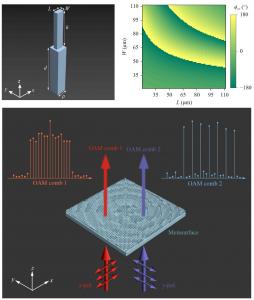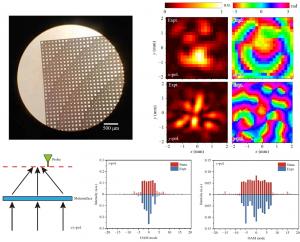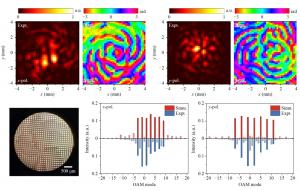Generation and multiplexing of double-polarized terahertz vortex combs
USA, September 3, 2024 /EINPresswire.com/ -- Electromagnetic waves with vortex-shape, namely vortex beams, are important in various fields. However, multi-mode OAM beams are rarely seen. To solve this, the researchers in China propose a metasurface design scheme that generates double-polarized vortex combs in the terahertz band, with flexible control of the mode numbers, positions, and intervals. The vortex comb has the characteristics of mode and polarization multiplexing, so it may help with the design of a high-capacity terahertz communication system.
Introduction
As a new degree of freedom, the orbital angular momentum of electromagnetic waves exceeds the traditional frequency, phase, and amplitude, and is expected to promote the infinite expansion of channel capacity. Recently, a team of research professor Chao-Hai Du from Peking University and Professor Xiaofei Zang's research group from the University of Shanghai for Science and Technology have carried out in-depth cooperation. Based on the research foundation of both sides in the field of terahertz and metasurface, a new method of generating polarization-multiplexed terahertz vortex combs using all-silicon metasurface has been proposed. In this study (doi: https://doi.org/10.37188/lam.2024.038), the concept of a terahertz vortex comb is combined with metasurface technology. Through careful design, precisive machining, and systematic characterizing of the all-silicon metasurface, the flexible control of the mode number, position, and interval of vortex combs is realized, to successfully generate dual-polarized terahertz vortex comb, and promote the development of ultra-high-capacity terahertz multi-mode communication technology.
Recently, this work is entitled "Generation of polarization-multiplexed terahertz orbital angular momentum combs via all-silicon metasurfaces", and published in Light: Advanced Manufacturing. Ming-Zhe Chong, a graduate student at Peking University, is the first author of the paper. Chao-Hai Du, a research professor at Peking University, and Xiaofei Zang, a professor at Shanghai University for Science and Technology, are the corresponding authors. Other major contributing authors include Yiwen Zhou, a graduate student at Shanghai University for Science and Technology, and Zong-Kun Zhang, a graduate student at Peking University.
What is a vortex comb?
Vortex light, also known as a beam carrying orbital angular momentum (OAM beam), has an intensity distribution in the shape of a doughnut, and a phase distribution in the shape of a vortex around the center. The number of repetitions of different vortices around the center may be different. We use topological charges to describe this feature, and different topological charges correspond to different modes. Different modes of vortex light are combined in a way of equal intensity and equal interval to form a vortex comb.
Design of polarization-multiplexed meta-atoms
The researchers use the all-silicon rectangular columnar structure to design polarization-multiplexed meta-atoms, which have strong birefringence properties. By carefully selecting meta-atoms with different geometric structures, the phase of the x and y linearly polarized terahertz waves through which they pass can be controlled simultaneously, covering the entire 360° range.
Vortex combs with arbitrary mode numbers
According to the principle of phase optimization of Damman grating, the researchers design two sets of phase distributions, corresponding to two kinds of vortex optical combs with different mode numbers, and map them to meta-atoms with different geometric structures, so that the desired metasurface is obtained. Next, the researchers use the Bosch process to prepare the sample and use the terahertz near-field scanning system to characterize it, thus obtaining the required vortex combs. Through the mode analysis of the field distribution, we can see that these vortex modes together constitute the vortex optical comb.
Vortex combs with arbitrary mode locations and intervals
Next, the researchers analyze the relationship between the Fourier transform and the vortex combs in the polar coordinate system, and design two sets of phase distributions. By using the same method to design, prepare, and characterize the metasurface, and conducting mode analysis, we can see that the two vortex combs have different mode locations and intervals.
DOI
10.37188/lam.2024.038
Original Source URL
https://doi.org/10.37188/lam.2024.038
Funding information
This work was supported by the National Key Research and Development Program of China (No. 2019YFA0210203), and the National Natural Science Foundation of China (No. 62271011, No. 61971013).
Lucy Wang
BioDesign Research
email us here
Legal Disclaimer:
EIN Presswire provides this news content "as is" without warranty of any kind. We do not accept any responsibility or liability for the accuracy, content, images, videos, licenses, completeness, legality, or reliability of the information contained in this article. If you have any complaints or copyright issues related to this article, kindly contact the author above.



